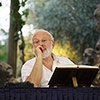Spiritual Holidays, Part 6
 From the Yom Kippur to Hanukkah
From the Yom Kippur to Hanukkah
Question: During Yom Kippur (the Day of Atonement) a person makes a restriction on all one’s desires because one wants to become similar to the Creator and not receive anything. Then a person corrects all one’s seven types of desires and on the eighth day receives the Torah, the light. Then comes Hanukkah. What does this holiday symbolize?
Answer: Hanukkah symbolizes the correction of a person to the state when one reaches the quality of Bina, the quality of complete bestowal. From Malchut one rises to the Sefira of Bina where one is completely in bestowal and does not need to receive anything.
Question: Does it mean that one has already corrected the seven first Sefirot during Sukkot and now has ascended to Bina?
Answer: No. These are all nominal, private corrections, not at full capacity. After all the holidays, precisely by receiving the Torah (upper light), one begins to correct oneself.
Until the end of Sukkot, until Shemini Atzeret, a person is not being truly corrected. A person did all the preparatory work to attract the upper light upon oneself.
Starting from the end of the holiday of Sukkot, from Shemini Atzeret to Hanukkah, one corrects oneself in the quality of Bina, in the quality of bestowal.
Question: Hanukkah represents a historical event that took place in the second century BC: an ideological conflict between the Maccabees and the Greeks. According to Kabbalah, the Greeks represent our egoistic desires and the Maccabees represent our altruistic desires.
The most interesting thing is the miracle that happened during Hanukkah. What is it?
Answer: The Maccabees found a small jar with the seal of the High Priest (Cohen), which contained the oil usually used in the Temple. From this oil they lit a lamp, and it burned all seven days of Hanukkah.
This is considered the miracle of Hanukkah and represents the fact that if a person correctly prepares oneself from below and is ready to be both the oil and the candle, then the Creator completely corrects the person, and one reaches one’s complete correction in the upper light of Bina, meaning one rises to the level of complete bestowal.
Question: Does it mean that a candle, a wick, and oil symbolize certain actions that a Kabbalist does with his or her desires?
Answer: Yes. And Hanukkah itself is “Hanu-Koh,” a stopover, when a person finishes correcting oneself in the quality of bestowal and moves to the next degree to the correction in the quality of reception for the sake of bestowal.
[257493]
From KabTV’s “Fundamentals of Kabbalah,” 1/29/19
Related Material:
Spiritual Holidays, Part 5
Spiritual Holidays, Part 4
Spiritual Holidays, Part 3







Discussion | Share Feedback | Ask a question